Power Electronics MCQs
1) Which of the given device is the fastest switching device
- MOSFET
- Triode
- BJT
- JEFT
Answer: a
Explanation: The term MOSFET stands for Metal Oxide Semiconductor Field Effect Transistor. It is one of the most common transistors in digital electronics. It is a majority charge carrier device with the fastest switching because it does not have minority charge carriers which take more time in settling down.
2) A snubber circuit is used to
- Limit the rate of rising in voltage across BJT
- Limit the rate of rising in voltage across SCR
- Limit the rate of rising in current across TRIAC
- Limit the rate of rising in current across BJT
Answer: b
Explanation: Snubber circuit refers to a kind of DV/dt protection circuit of the thyristor. It is used to limit the high rate of change of voltage from cathode to anode. It is usually used to protect SCR thyristor from high DV/dt and di/dt stress.
3) If the maximum value of applied voltage for a full-wave center ap (M-2) rectifier is 30 V, find the magnitude of ripple voltage
- 83.88
- 84.52
- 87.62
- 89.59
Answer: b
Explanation:
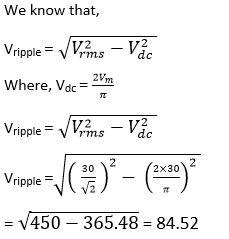
4) Find the displacement power factor of a single-phase fully controlled rectifier in which feeds constant DC current in a load when a magnitude of power angle is 300

Answer: c
Explanation:
Given, ∅=300
We know that,
Displacement factor = cos?∅ = cos300 =
5) In the forward blocking mode of a silicon controlled rectifier, the SCR is
- In on state
- In natural state
- Forward biased state
- In off state
Answer: d
Explanation: The forward blocking mode of a silicon-controlled rectifier refers to a mode when the anode is made positive with respect to the cathode. It is also called off state.
6) A silicon controlled rectifier is turned on if the anode current is greater than
- Trigger current
- Anode current
- Cathode current
- Holding current
Answer: c
Explanation: SCR stands for Silicon Controlled Rectifier. Once the SCR is turned on, it will remain in the same conducting state until the anode current becomes lower than the holding current.
7) The anode current passing through a conducting silicon-controlled rectifier is 20 A. If its gate current is made half, what will be the anode current?
- 10 A
- 20 A
- 5 A
- 30 A
Answer: b
Explanation: Once the SCR gets active or in on state, the gate current has no control over it. So the value of current remains unchanged.
8) A silicon controlled rectifier is turned off mode when its turn off time is
- Greater than the circuit turn off time
- Less than the circuit turn off time
- Equal to the circuit turn off time
- None of these
Answer: b
Explanation: The term turns off means that it has changed its form from on to off state and capable of blocking the forward voltage.
9) A 1 – ∅ full-wave rectifier is made by using thyristors. If the peak value of the sinusoidal input voltage is Vm and the value of the delay angle is ?/4 radian, find the average value of output voltage
- 0.25 V
- M
- 0.45 VM
- 0.65 VM
- 0.85 VM
Answer: b
Explanation: We know that for a single-phase full-wave rectifier
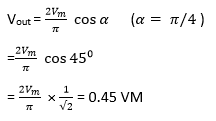
10) The TRIAC is the same as
- Two SCR connected in parallel
- Two SCR connected in antiparallel
- One SCR and one thyristor connected in parallel
- Two SCR connected in series
Answer: b
Explanation: TRIAC is an abbreviation for a three-terminal ac switch. If we divide TRIAC, we get TRI ana AC. “TRI,” as the name suggests that the device consists of three terminals, and “AC” means that the device controls the alternating current. It is a four-layer, 3 terminal bidirectional device.
11) A half-wave rectifier circuit using an ideal diode has an input voltage of 10 sin ?t V; find the average and RMS value of output voltage?
- 3.18 V, 5V
- 3.68 V, 8V
- 4.18 V, 5V
- 4.68 V, 8V
Answer: a
Explanation:
Given;
Maximum input voltage = 10 V
We know that, for half wave rectifier circuit

And rms value of the output voltage

12) A solar cell of 450 V supplies power to an ac source of 440 V, 50 Hz through a 3 phase fully controlled bridge converter. An inductance with a value of 10 A is connected to the dc circuit to maintain the dc current. If the resistance of the solar cell is 1 Ω, each thyristor will be reverse biased for a period of
- 1480
- 1380
- 1280
- 1180
Answer: b
Explanation: Given;
EMF of a solar cell = 450 V
DC current Idc = 10 A
Resistance of solar cell, Rcell = 1 ?
We know that, Voltage across the inverter = output voltage of the solar cell,
Vout = -(450 – 10 × 1) = -440 V
For three phase controlled bridge
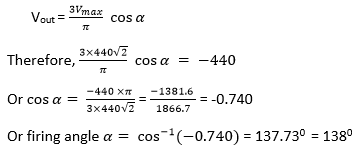
13) A 1 – ∅ full wave rectifier is designed using thyristors. It the peak value of the sinusoidal input voltage Vm and the delay angle is radian, find the average value of output voltage?
radian, find the average value of output voltage?
- 0.35 Vmax
- 0.45 Vmax
- 0.55 Vmax
- 0.65 Vmax
Answer: c
Explanation:
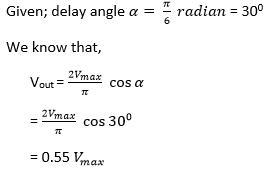
14) Which of the given device is the most suitable power device for a higher frequency (above 100 kHz) switching application
- SCR
- Power MOSFET
- GTO
- BJT
Answer: b
Explanation: Most suitable power device for higher frequency (above 100 kHz) switching application is power MOSFET because it has lower switching losses. So, for lower frequency switching applications, BJT is used.
15) Which of the given device is a modern semiconductor device that combines the characteristics of MOSFET and BJT?
- SCR
- Schottky diode
- Microwave transistor
- IGBT
Answer:
Explanation: IGBT stands for Insulated Gate Bipolar Transistor. It includes the best features of power MOSFETS and power transistors(BJT). Same as a MOSFET, it has low input capacitance and high input impedance. In one state, it has low resistance and high current controlling capacity like a BJT.
16) The thyristor is equivalent to a thyratron tube is
- BJT
- SCR
- TRIAC
- GTO
Answer: b
Explanation: The thyristor is known as SCR because it is a silicon device used as a rectifier and that rectification can be controlled. It is made up of silicon only because the leakage current in silicon is less than that of germanium. If any device is used as a switch, it is necessary that leakage current must be minimum.
17) A single-phase controlled, a full-bridge converter is supplying a highly inductive DC load. The conductor is fed from a 220 V, 50Hz, ac source. Find the fundamental frequency in Hz of the voltage ripple on the dc side
- 300 Hz
- 220 Hz
- 100 Hz
- 50 Hz
Answer: c
Explanation: The formula to caculate the even harmonics are given as
= 2fS= 2 × 50 = 100 Hz
18) A single-phase fully controlled thyristor bridge ac dc converter is operating at a firing angle is 300 and overlap angle is 200 constant dc output current of 10 A. find the fundamental power factor at input ac mains?
- 0.968
- 0.766
- 0.163
- 0.586
Answer: b
Explanation:
Given;
α = 300
µ = 200
We know that the fundamental power factor or displacement factor at input ac mains.
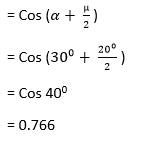
19) Find the average output of a semiconverter connected to a 220 V, 50 Hz power supply, and firing angle is 
- 178.52
- 248.05
- 148.55
- 198.49
Answer: c
Explanation:
Given;
Firing angle α =
We know that the average output voltage of a semiconductor is given as
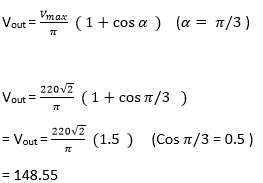
20) A freewheeling diode is phase-controlled rectifiers.
- Stops rectifier operations
- Improves line power factor
- Is the reason for additional harmonics
- Is the reason for the sudden breakdown
Answer: b
Explanation: Freewheeling diode is also called bypass diode or commutating diode. It is used to improve the waveform of the loaded current and power factor. It is connected across a realy, which is driven by a transistor. It enables for dissipation of energy stored in the inductance of the load in the circuit and provides a continuous flow of load current when the thyristor is blocked.
21) In a three-phase bridge rectifier, the maximum conduction of each thyristor is
- 1200
- 900
- 300
- 600
Answer: a
Explanation: In a three-phase bridge rectifier, the maximum conduction of each thyristor is 1200
22) In a 3-∅ controlled bridge rectifier, the frequency of ripple in the output voltage depends on
- Power factor
- Supply frequency
- Voltage source
- Firing angle
Answer: b
Explanation: In a three-phase controlled bridge rectifier, the ripple frequency in the output voltage depends on supply frequency. The frequency of ripple in the output voltage
Fout = total number of pulses × supply frequency
In a 3-Ø controlled bridge rectifier, the ripple frequency in the output voltage is 6 times the supply frequency.
23) A three-phase full converter is supplying a purely resistive load at 220 V dc for 00 firing angle, find the output voltage for 900 firing angle
- 30 V
- 0 V
- 90 V
- 120 V
Answer: b
Explanation: We know that,

24) What is the name of a converter which can work on both in 3-pulse and 6 pulse modes?
- Three-phase full-wave converter
- Three-phase half wave converter
- Three-phase semi converter
- Single-phase semi converter
Answer: c
Explanation: A three-phase converter has an additional feature that it works as a 6 pulse converter for firing angle α < and as a three pulse converter for firing angle α ≥
and as a three pulse converter for firing angle α ≥
25) A three phase full controlled converter can operate as a
- Converter for α = 0 to 1200
- Converter for α = 0 to 900
- Converter for α = 0 to 1800
- Converter for α = 0 to 600
Answer: c
Explanation: As we know, a three-phase full controlled converter operates in only two quadrants (First and Fourth).
26) A 3 phase, 6 pulse SCR converter is connected to a voltage source of 220 V, 50 Hz, AC mains, and controlling a dc drive with terminal voltage 210 V and rated current value is 90 A. If the commutation angle µ = 150 and firing angle α= 60,0, find the rating of shunt compensator and power factor.
- 1
- 0.5
- 2
- 1.5
Answer: b
Explanation:
Given;
V = 210
I = 90 A
α= 600
We know that, Shunt compensation
= VI tan alpha;
Putting the value V , I, and αin above equation we get
= 210 × 90 tan 600
= 72, 735 VAR = 72.8 KVAR
And power factor =
Cos α= Cos 600 = 0.5
27) Which of the given regulator provide output voltage polarity reversal without the involvement of a transformer.
- Linear voltage regulator
- Shunt voltage regulator
- Buck-Boost regulator
- Series voltage regulator
Answer: c
Explanation: Buck-boost regulator provides output voltage polarity reversal without a transformer. The buck-boost converter refers to a voltage regulator used to regulate dc power supplies. A negative polarity output may be required with respect to the same terminal of the input voltage. The output voltage can be either more or less than the input voltage.
28) A chopper converts
- AC to DC
- AC to AC
- DC to AC
- DC to DC
Answer: d
Explanation: Choppers refer to a static switch used to provide Variable DC voltage from a constant DC voltage source. It is a DC to DC converters. It can be either step up or step down DC to DC converter. In Step up DC converter, the output voltage is less than the input voltage. It is also known as Buck converter. In step-up, DC converter, which is also called Boost Converter, is opposite to buck converter. There is also a converter based on the combination of these two; it works in both buck and boost mode depending upon operating conditions; this type of chopper is called Buck-Boost Converter.
29) A chopper circuit works on TRC control mode at a frequency of 4 kHz of a 220 V dc supply. For 180 V output voltage, find the conduction and blocking periods of a thyristor in each cycle.
- 0.209 ms, 0.234 ms
- 0.404 ms, 0.055 ms
- 0.204 ms, 0.045 ms
- 0.704 ms, 0.897 ms
Answer: c
Explanation:
Given;
Vout = 180 V
Vs = 220 V
f = 4 kHz = 4 × 10 3
We know that,
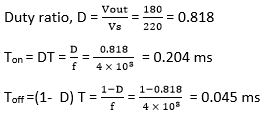
30) A four-quadrant chopper can not be operated as
- Thyristor
- Cycloconverter
- One quadrant chopper
- Inverter
Answer: b
Explanation: A cycloconverter is a kind of AC to AC converter based on thyristors that converts AC at one frequency to ac of another frequency without the involvement of a dc source. It is used primarily to increase or decrease the frequency of the output voltage(s) with respect to the frequency of the input voltage(s), without using any AC-DC nor DC-AC converters during the process. The supply side of the cycloconverter is considered as the input, while the load side is considered the output of it.
31) If a step-up chopper has source voltage V and duty cycle α, find the chopper’s output voltage.

Answer: c
Explanation:
Given;
Source voltage= V
Duty cycle = α
We know that
The average value of output voltage of the step-up chopper is given as

Where
V is the voltage source, and α is the duty cycle.
32) How many switches are used to build a three-phase to three-phase cycloconverter?
- 10
- 14
- 18
- 24
Answer: c
Explanation: 18 switches are required to construct a three-phase to three-phase cycloconverter. Three phases of a three-phase cycloconverter need three sets of three-phase half-wave circuits, and each circuit needs 6 thyristors. So the total number of thyristors required is 18.
33) A three-phase to three-phase cyclo converter requires
- 24 SCRs for 6 pulse device
- 36 SCRs for 6 pulse device
- 48 SCRs for 3 pulse device
- 24 SCRs for 3 pulse device
Answer: b
Explanation: A three-phase to three-phase cyclo converter requires 36 SCRs for 6 pulse devices.
34) In a three-phase to single phase cycloconverter using a 6 pulse bridge circuit, if the input voltage is 220 V per phase, find the value of the fundamental RMS value of the output voltage?

Answer: d
Explanation:
Given;
Total number of pulses (m) = 6
Input phase voltage (VP) = 220 V
We know that the fumdamental value of rms output voltage is given by
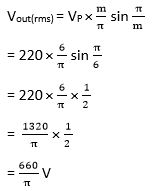
35) A three-phase cycloconverter is used to find the variable frequency single-phase ac output. If the single-phase ac load is 240 V, 50 A at a power factor of 0.8 lagging, find the RMS value of input voltage per phase
- 220 V
- 240 V
- 290 V
- 20 V
Answer: c
Explanation:
Given,
Vout(rms)= 240 V
m = 3 (for 3 phase)
We know that the fumdamental value of rms output voltage is given by
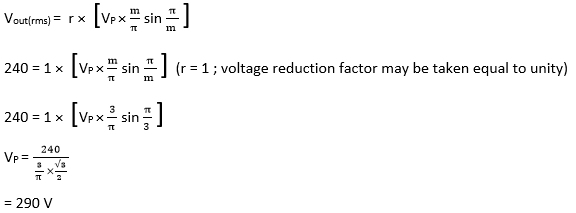
36) A single-phase, half-bridge inverter has an input voltage of 60 VDC. If the inverter is feeding a load of 3.6 ohms, find the RMS output voltage at a fundamental frequency
- 188 V
- 168 V
- 158 V
- 178 V
Answer: a
Explanation:
Given,
Vs = 60
We know that the fundamental component of the output voltage of a single-phase half-bridge inverter is given as
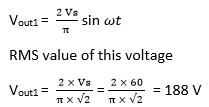
37) PWM switching is used in voltage source inverters for the purpose of
- Controlling output current
- Controlling input voltage
- Controlling input power
- Controlling output harmonics and output voltage.
Answer: d
Explanation: PWM stands for Pulse Width Modulation. It is used in the voltage source inverter to control the output voltage and output harmonics. It is a method of controlling the average power of a signal over a continuous range by switching it between on and off states. It is a method of generating amplitude modulation. By increasing the number of pulses per half cycle, the order of harmonic frequency increases so that the filter’s size is reduced.
38) A single-phase full-bridge voltage source inverter (VSI) is fed from a 240 V dc source. If a pulse of 600 duration is used to trigger the devices in each half-cycle, find the RMS value of the fundamental component of the output voltage.
- 128 v
- 148 V
- 108 V
- 168 V
Answer: c
Explanation:
Given pulse duration (d) = 600
Vs = 240 V
We know that pulse width is given as
2d = 600
D = 300
So the RMS value of the fundamental component of the output voltage is given as
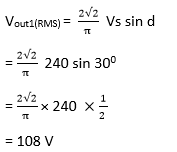
39) An electric motor, developing a starting torque of 18 Nm, starts with a load toque of 9 Nm on its shaft. If the acceleration at the initial point is 3 rad/sec2, find the moment of inertia of the system(Ignore friction)
- 3 Kg – m2
- 9 Kg – m2
- 27 Kg – m2
- 81 Kg – m2
Answer: a
Explanation:
Given,
Starting toque Test of the motor = 18 Nm
Load toque TL= 9 Nm
Accelarating toque Ta = Tst- TL = 18 Nm – 9 Nm = 9 Nm
Accelaration α =3 rad/sec2
We know thar moment of inertia is given as

40) If a 3 phase semi converter is feeding by a separately excited dc motor at constant field current, the motor can operate in the given condition.
- Speed positive and toque negative
- Speend positive and toque positive
- Speed negative and toque positive
- Speed negative and toque negative
Answer: b
Explanation: 3-∅ semiconverter drive only in a single quadrant; therefore, the moto can operate only in the first quadrant, which has positive speed and positive toque.
41) A 240 V, 1200 rpm. 30 A separately excited dc motor has an armature resistance of 3 ohms. A step-down chopper controls the dc motor with a frequency of 1 kHz. The input dc voltage given to the chopper is 280 V. If the duty cycle of the chopper for the motor to operate at a speed of 700 rpm, find the rated toque
- 0.233
- 0.338
- 0.633
- 0.951
Answer: b
Explanation:
Given,
Rated speed (N1) = 1200 rpm
Voltage across the armature (Va1) = 240 V
Armature current (Ia) = 30 A
Armature resistance (Ra) = 3 ohm
Rated speed (N2) = 700 rpm and Vs=280 V
We know that,
The rated speed of 1200 rpm voltage across the motor armature,
Va1= Eb1+ Ia Ra
Eb1 = Va1– Ia Ra
= 240 – 30 × 3
= 240 – 90 = 150 V
At 700 rpm,
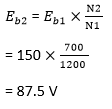
At rated toque, armature current will also be rated that is 30 A because the current is directly proportional to the toque
So the applied voltage
Va2= Eb2+ Ia Ra
= 87.5 + 30 × 3
= 177.5 V
So the duty ratio,

42) A single-phase half-controlled rectifier is driving a separately excited dc motor. The back emf constant of the motor is 0.30 V/rpm. The armature current’s value is 8 A without any ripple, and the armature resistance is 3 ohm. The converter is working from a 240 V power supply of a single phase ac source with a firing angle of 600. Find the speed of the dc motor under this condition
- 120. 6 rpm
- 168. 7 rpm
- 190. 2 rpm
- 240. 8 rpm
Answer: c
Explanation:
Given,
The back emf constant of the motor Eb = 0.30 V/rpm
Armature current (Ia) = 8 A
Armature resistance (Ra) = 3 ohm
Vmax = 240 V
Firing angle α = 600
We know that,
The average output voltage of a single phase half controlled rectifier is given as
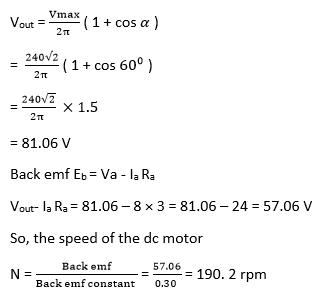
43) The armature current of a dc motor fed from a thyristor power converter consists of ripples. The ripple in the armature affects
- Commutation of the motor
- Speed of the motor
- Toque of the motor
- The efficiency of the motor
Answer: a
Explanation: Ripple frequency refers to a frequency of the residual AC voltage. After that, it has been rectified to DC in a power supply. Because of higher ripple content in the converter output motor, heating and commutating problems arise. It works on high DC voltage. For a half-wave rectifier, the value of ripple frequency i the same as the AC frequency, and for a full-wave, the value of ripple frequency is twice the original AC frequency.
44) A motor armature is supplied through a phase control silicon controlled rectifiers receives a smoother voltage shape at
- Lower motor speed
- Constant motor speed
- Higher motor speed
- None of these
Answer: c
Explanation: We know that the voltage is directly proportional to the speed. Therefore smoother voltage shape is achieved at a higher speed.
45) The torque produced by a single-phase induction motor fed by an ac voltage controller for speed control due to
- A fundamental component of harmonics as well as current
- A fundamental component of harmonics only
- A fundamental component of current only
- Fundamental component and even harmonics
Answer: c
Explanation: Single-phase induction motors work on single-phase AC supply. It has two windings; Main windings and auxiliary winding. For speed control of a single-phase induction motor by an ac voltage controller, and only a fundamental component of current is required to develop a toque. The harmonics in the motor current may cause power losses resulting in heating of the motor.
46) A resistance of 4 ohms is connected in the rotor circuit, and a resistance of 8 ohms is additionally connected during OFF periods of a chopper. The OFF period of the chopper is 6 ms. Find the average resistance in the rotor circuit for the chopper frequency off 200 Hz.
- 20.6 ohm
- 15.5 ohm
- 25.9 ohm
- 1.8 ohm
Answer: b
Explanation:
Given,
Normally a 4-ohm resistor is connected to the rotor circuit during off periods; r = 8 ohm is additional
Toff = 6 ms
f = 200 Hz
We know that frequency is reciprocal of a period
So,

47) When a self-controlled synchronous motor fed from a variable frequency inverter
- The speed of the stator decides stator speed
- Stability problems occur
- The frequency of the stator decides the rotor speed
- The frequency of the rotor decides the rotor speed
Answer: c
Explanation:
As we know,
The synchronous motor always runs at synchronous speed

Where,
f = frequency
p = number of poles.
So the rotor speed is decided by the stator frequency supply.
48) A 3-∅ fully controlled thyristor bridge converter is used as a line commutated inverter to feed 60 kW With the power 450 V dc to a three-phase, 430 V (line), 50 Hz ac mains. If the dc-link current is constant, find the RMS current of the thyristor.
- 54.68 A
- 76.98 A
- 66.08 A
- 16.88 A
Answer: b
Explanation:
Given,
DC link current Id = Constant
DC link voltage Vd = 450 V
P = 60×103
So, the power supllied to the motor is given as
P = Vd Id
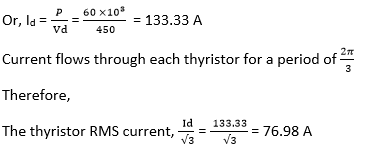
49) A cycloconverter fed induction motor drive is widely used for which one of the following?
- Compressor drive
- Machine tool drive
- Papermill drive
- Cement mill drive
Answer: b
Explanation: Cycloconverters are mainly used where precise speed control is needed. It means cycloconverter is not suitable for cement mill drive as well as compressor drive. Papermill requires constant speed drive. So cycloconverter fed induction motor drive is widely used for machine tool drive.
50) Which of the given configurations is used for both regenerative and motoring breaking?
- First quadrant chopper
- Fourth quadrant chopper
- Third quadrant chopper
- Two quadrant chopper
Answer: d
Explanation: Two quadrant chopper is used for both regenerative and motoring breaking.
51) A dc chopper is used in the regenerative braking mode of a dc series motor. The dc supply is 400 V, and the duty cycle is 60%. The average value of armature current is 80 A. If it is considered as continuous and ripply free, find the value of power feedback to the supply?
- 28200 W
- 19200 W
- 21240 W
- 19220 W
Answer: d
Explanation:
:
Given,
Vout = 400 V
Duty cycle α = 0.6
Armature current IS = 80 A
We know that for regenerative mode, chopper os worked as a step-up chopper
Therefore,

= 600(1 – 0.6) = 240 V
Now the power supplier back to the supply
= VS IS = 240 × 80 = 19200 W
52) Power diode is
- Two terminal semiconductor device
- Three terminal semiconductor device
- Four terminal semiconductor device
- None of these
Answer: a
Explanation: A power diode refers to a semiconductor device that is used to convert alternating current to direct current. It consists of two terminals, cathode and anode, the same as that of a normal diode. A power diode is nothing but a signal diode with an extra layer.
53) The V-I characteristics of diode lie in the
- First quadrant
- Fourth quadrant
- The third and second quadrant
- The first and third quadrant
Answer: d
Explanation: V- I characteristics of diode lies in the first and third quadrant. The first quadrant works in the forward region, and the third quadrant works in reverse biased mode.
54) Find a triple frequency of a six-phase half-wave rectifier for 220 V 50 Hz input
- 150 Hz
- 300 Hz
- 50 Hz
- 600 Hz
Answer: b
Explanation:
In a six-phase half-wave rectifier, usually six diodes are used. Since the supply frequency is 50 z, therefor the ripple frequency is six-time that of the power supply
= 50 × 6 = 300 Hz
55) If a firing angle α of a single phase fully controlled rectifier feeding a constant DC current into the load is 600, Find the displacement factor of the rectifier
- 0
- 0.5
- 1
- 1.5
Answer: b
Explanation: Displacement factor refers to the power factor due to the phase shift between voltage and current at fundamental line frequency.
SO,
The displacement power factor is given as = Cos?
? is 600
Therefore, Cos600 = 0.5
56) A forward-biased PN junction acts as a/an
- Thyristor
- Closed switch
- Amplifier
- Chopper
Answer: b
Explanation: PN junction diode refers to a diode that is formed when a p-type semiconductor is fused with an n-type semiconductor. It creates a potential barrier across the diode junction. In forward biasing conditions, the PN junction diode acts as a closed switch.
57) For a specific transistor, if the value of beta is equal to 400 and the Base current is 8mA, Find the value of Emitter current?
- 4.308
- 3.208 A
- 7.808 A
- 9.276 A
Answer: b
Explanation:
Given,
Current Gain β = 400
Base current IB = 8mA
The dc current gain βdc refers to the collector current ratio to base current at constant VCE under dc biasing conditions.
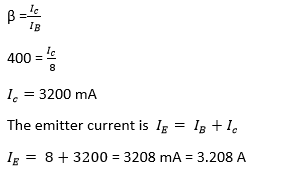
58) The two-transistor model of an SCR obtained by
- Bisecting the SCRs diagonally
- Bisecting the SCRs top and bottom two layers
- Bisecting the SCRs only bottom two layers
- Bisecting of SCRs horizontally
Answer: b
Explanation: The two-transistor models of an SCR are obtained by bisecting the SCRs top and bottom two layers. SCR is a unidirectional device that works like a diode. It enables current to flow in a single direction only.
59) In an SCR, the gate cathode characteristics have a slope of 160. If the gate power dissipation is 0.8 watt, find the value of the gate current?
- 110 mA
- 220mA
- 71 mA
- 31 mA
Answer: c
Explanation:
Given,
Slope = 160
We know that
Power is defined as the product of voltage and current
Therefore,
P = Vg× Ig = 0.8
Slope Vg / Ig = 160
Vg = 160 × Ig
160 I2g = 0.8
Ig = 71 mA
